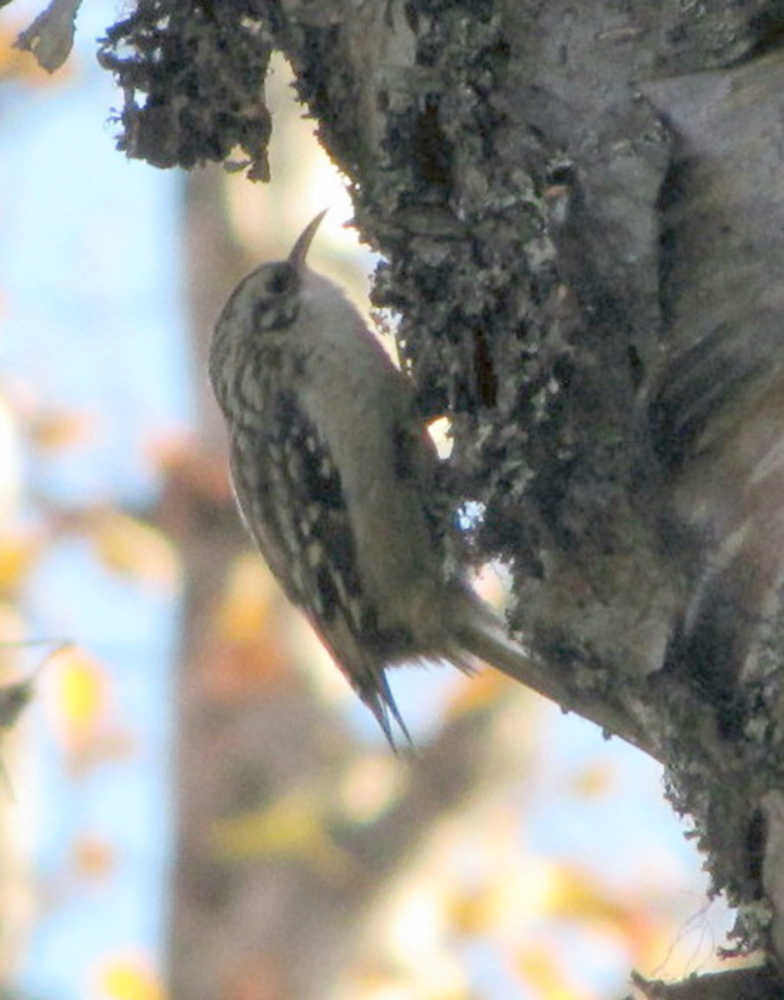I have seen more brown creepers on the Kenai Peninsula this year than in the past two years when I saw none. Brown creepers are tiny, brownish-gray, woodpecker-like birds that are cryptically colored, perfectly blending into the brownish-gray patterns of tree bark. They are not only visually inconspicuous, but their short, high frequency calls are easily missed. A typical call consists of 4-9 faint, very high pitched notes that last only about a second each.
Here on the Kenai, they often fly to the bottom of large, old white or black spruces trees and begin creeping upward, like woodpeckers, probing for insects and spiders hidden in the furrowed bark and plucking them out with their thin, delicate, slightly curved bills. They also find prey behind amongst the loose bark of birch trees. It’s rare to see brown creepers feeding on smooth-barked trees such as aspen.
Your chances of seeing brown creepers are the greatest in old growth forests. In the 1970s, Sue Quinlan, working on the Peninsula’s Chugach National Forest, reported that brown creepers were most abundant in old growth forest stands over 100 years old. But, in the 1990s, other studies indicated a decline in the abundance of brown creepers throughout south-central Alaska probably because many large dead and dying white spruce trees (from the spruce bark beetle infestation) were removed by logging. The decline is understandable since brown creepers frequently build their well hidden nests behind loose bark on dead and dying trees.
Apparently only the female incubates the eggs, but she is regularly fed on the nest by the male. They likely compete for food with red-breasted nuthatches, woodpeckers, chickadees and kinglets but whether this competition effects their reproduction or populations is unknown.
Brown creepers are the only member of the creeper family of birds (Certhidae) in North America. Creepers are believed to have originated in the Old World (known there as treecreepers) and later spread to North America. Because brown creepers are not as winter-adapted as chickadees and nuthatches, they sometimes withdraw from the coldest part of their range in harsh winters and become short distance migrants. However, little is known about their migratory habits in Alaska. I have seen them on the Kenai during winters but unfortunately for winter bird watchers, they seldom visit bird feeders.
My closest encounter with a brown creeper and one of my most memorable wildlife experiences happened years ago. I was standing motionless watching a family of brown creepers fly from tree to tree. One of the young ones flew up to me, landed on my brown plaid flannel shirt and began “creeping” up my chest. But it soon realized that I was not the trunk of a tree and flew off to rejoin its family. I felt lucky to have experienced such a unique encounter.
I don’t know why I have seen brown creepers more often this year than I have in the past several years. I walked the same routes and trails. Has the resident population increased? Have habitat conditions improved? Did last year’s relatively mild winter increase their survival? Were previous winters too harsh on the birds? Are the creepers seen here on the Kenai Peninsula in the fall actually short-distance migrants fleeing colder parts of Alaska?
I have always been interested in elusive species like brown creepers because many aspects of the lives of such species are still unknown. And the brown creeper is a prime example.
Dr. Ted Bailey retired from the Kenai National Wildlife Refuge where he was the supervisory wildlife biologist for many years. He has lived on the Kenai Peninsula for over 38 years and still maintains a keen interest in its wildlife and natural history. Find more information about the Kenai National Wildlife Refuge at http://kenai.fws.gov or http://www.facebook.com/kenainationalwildliferefuge.

